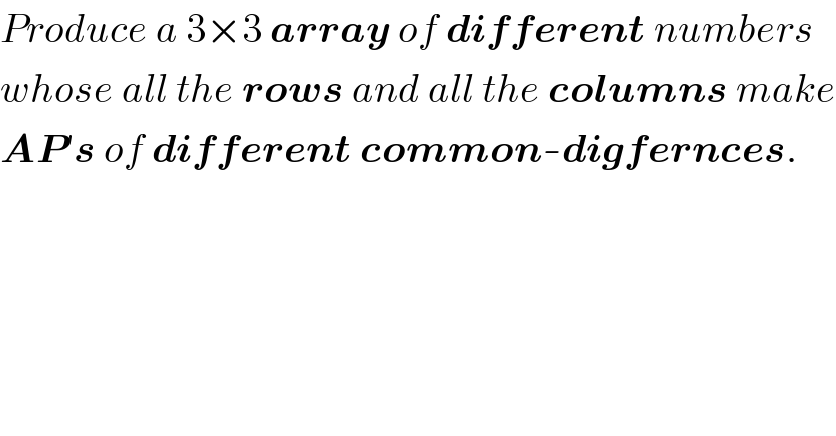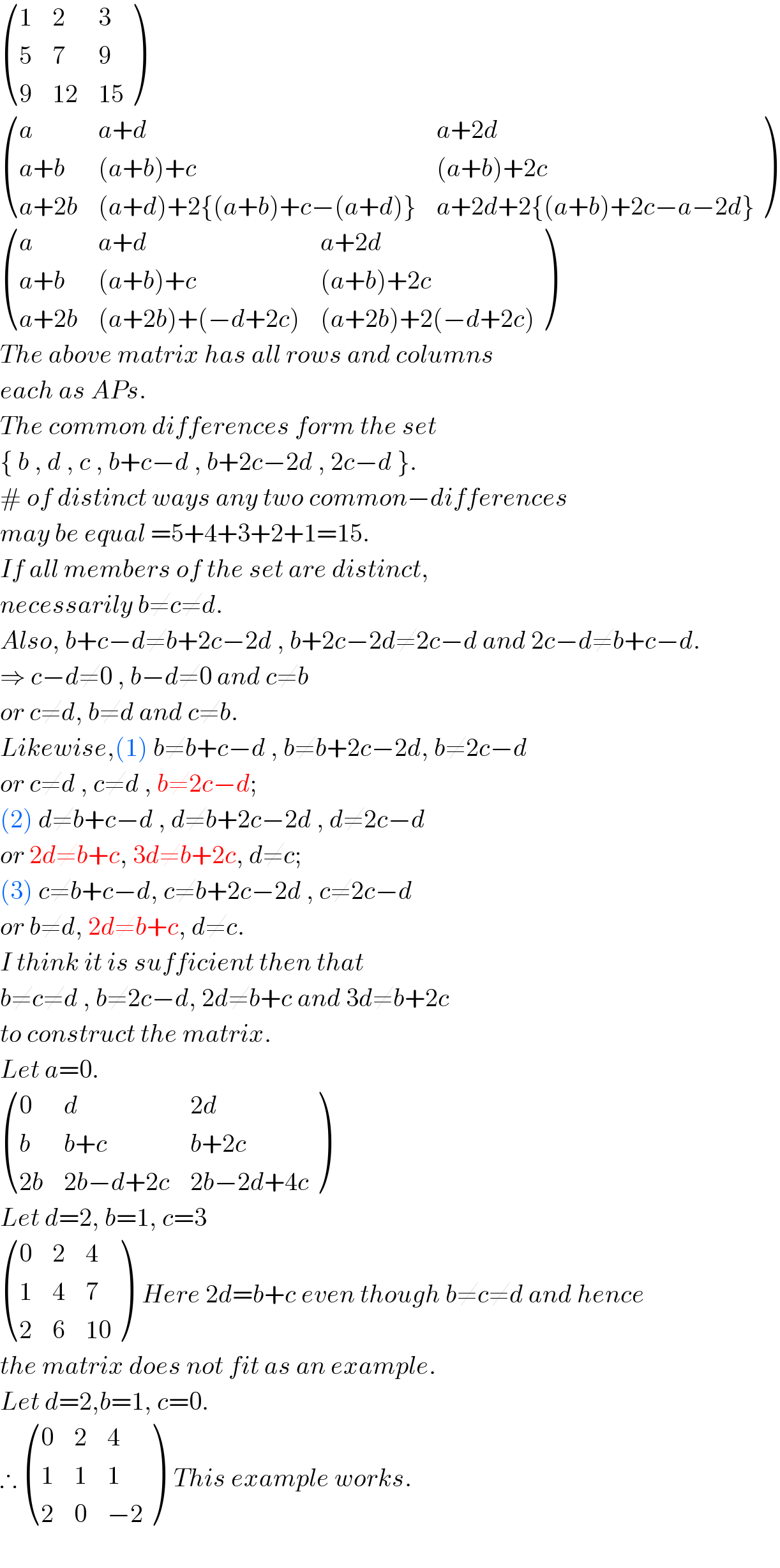
Question Number 7423 by Rasheed Soomro last updated on 28/Aug/16

$${Produce}\:{a}\:\mathrm{3}×\mathrm{3}\:\boldsymbol{{array}}\:{of}\:\boldsymbol{{different}}\:{numbers} \\ $$$${whose}\:{all}\:{the}\:\boldsymbol{{rows}}\:{and}\:{all}\:{the}\:\boldsymbol{{columns}}\:{make} \\ $$$$\boldsymbol{{AP}}'\boldsymbol{{s}}\:{of}\:\boldsymbol{{different}}\:\boldsymbol{{common}}-\boldsymbol{{digfernces}}. \\ $$
Commented by Yozzia last updated on 28/Aug/16

$$\begin{pmatrix}{\mathrm{1}}&{\mathrm{2}}&{\mathrm{3}}\\{\mathrm{5}}&{\mathrm{7}}&{\mathrm{9}}\\{\mathrm{9}}&{\mathrm{12}}&{\mathrm{15}}\end{pmatrix}\: \\ $$$$\begin{pmatrix}{{a}}&{{a}+{d}}&{{a}+\mathrm{2}{d}}\\{{a}+{b}}&{\left({a}+{b}\right)+{c}}&{\left({a}+{b}\right)+\mathrm{2}{c}}\\{{a}+\mathrm{2}{b}}&{\left({a}+{d}\right)+\mathrm{2}\left\{\left({a}+{b}\right)+{c}−\left({a}+{d}\right)\right\}}&{{a}+\mathrm{2}{d}+\mathrm{2}\left\{\left({a}+{b}\right)+\mathrm{2}{c}−{a}−\mathrm{2}{d}\right\}}\end{pmatrix}\: \\ $$$$\begin{pmatrix}{{a}}&{{a}+{d}}&{{a}+\mathrm{2}{d}}\\{{a}+{b}}&{\left({a}+{b}\right)+{c}}&{\left({a}+{b}\right)+\mathrm{2}{c}}\\{{a}+\mathrm{2}{b}}&{\left({a}+\mathrm{2}{b}\right)+\left(−{d}+\mathrm{2}{c}\right)}&{\left({a}+\mathrm{2}{b}\right)+\mathrm{2}\left(−{d}+\mathrm{2}{c}\right)}\end{pmatrix}\: \\ $$$${The}\:{above}\:{matrix}\:{has}\:{all}\:{rows}\:{and}\:{columns} \\ $$$${each}\:{as}\:{APs}.\: \\ $$$${The}\:{common}\:{differences}\:{form}\:{the}\:{set} \\ $$$$\left\{\:{b}\:,\:{d}\:,\:{c}\:,\:{b}+{c}−{d}\:,\:{b}+\mathrm{2}{c}−\mathrm{2}{d}\:,\:\mathrm{2}{c}−{d}\:\right\}. \\ $$$$#\:{of}\:{distinct}\:{ways}\:{any}\:{two}\:{common}−{differences}\: \\ $$$${may}\:{be}\:{equal}\:=\mathrm{5}+\mathrm{4}+\mathrm{3}+\mathrm{2}+\mathrm{1}=\mathrm{15}. \\ $$$${If}\:{all}\:{members}\:{of}\:{the}\:{set}\:{are}\:{distinct}, \\ $$$${necessarily}\:{b}\neq{c}\neq{d}. \\ $$$${Also},\:{b}+{c}−{d}\neq{b}+\mathrm{2}{c}−\mathrm{2}{d}\:,\:{b}+\mathrm{2}{c}−\mathrm{2}{d}\neq\mathrm{2}{c}−{d}\:{and}\:\mathrm{2}{c}−{d}\neq{b}+{c}−{d}. \\ $$$$\Rightarrow\:{c}−{d}\neq\mathrm{0}\:,\:{b}−{d}\neq\mathrm{0}\:{and}\:{c}\neq{b}\: \\ $$$${or}\:{c}\neq{d},\:{b}\neq{d}\:{and}\:{c}\neq{b}. \\ $$$${Likewise},\left(\mathrm{1}\right)\:{b}\neq{b}+{c}−{d}\:,\:{b}\neq{b}+\mathrm{2}{c}−\mathrm{2}{d},\:{b}\neq\mathrm{2}{c}−{d} \\ $$$${or}\:{c}\neq{d}\:,\:{c}\neq{d}\:,\:{b}\neq\mathrm{2}{c}−{d}; \\ $$$$\left(\mathrm{2}\right)\:{d}\neq{b}+{c}−{d}\:,\:{d}\neq{b}+\mathrm{2}{c}−\mathrm{2}{d}\:,\:{d}\neq\mathrm{2}{c}−{d} \\ $$$${or}\:\mathrm{2}{d}\neq{b}+{c},\:\mathrm{3}{d}\neq{b}+\mathrm{2}{c},\:{d}\neq{c}; \\ $$$$\left(\mathrm{3}\right)\:{c}\neq{b}+{c}−{d},\:{c}\neq{b}+\mathrm{2}{c}−\mathrm{2}{d}\:,\:{c}\neq\mathrm{2}{c}−{d} \\ $$$${or}\:{b}\neq{d},\:\mathrm{2}{d}\neq{b}+{c},\:{d}\neq{c}. \\ $$$${I}\:{think}\:{it}\:{is}\:{sufficient}\:{then}\:{that} \\ $$$${b}\neq{c}\neq{d}\:,\:{b}\neq\mathrm{2}{c}−{d},\:\mathrm{2}{d}\neq{b}+{c}\:{and}\:\mathrm{3}{d}\neq{b}+\mathrm{2}{c} \\ $$$${to}\:{construct}\:{the}\:{matrix}. \\ $$$${Let}\:{a}=\mathrm{0}. \\ $$$$\begin{pmatrix}{\mathrm{0}}&{{d}}&{\mathrm{2}{d}}\\{{b}}&{{b}+{c}}&{{b}+\mathrm{2}{c}}\\{\mathrm{2}{b}}&{\mathrm{2}{b}−{d}+\mathrm{2}{c}}&{\mathrm{2}{b}−\mathrm{2}{d}+\mathrm{4}{c}}\end{pmatrix}\: \\ $$$${Let}\:{d}=\mathrm{2},\:{b}=\mathrm{1},\:{c}=\mathrm{3} \\ $$$$\begin{pmatrix}{\mathrm{0}}&{\mathrm{2}}&{\mathrm{4}}\\{\mathrm{1}}&{\mathrm{4}}&{\mathrm{7}}\\{\mathrm{2}}&{\mathrm{6}}&{\mathrm{10}}\end{pmatrix}\:\:{Here}\:\mathrm{2}{d}={b}+{c}\:{even}\:{though}\:{b}\neq{c}\neq{d}\:{and}\:{hence} \\ $$$${the}\:{matrix}\:{does}\:{not}\:{fit}\:{as}\:{an}\:{example}. \\ $$$${Let}\:{d}=\mathrm{2},{b}=\mathrm{1},\:{c}=\mathrm{0}. \\ $$$$\therefore\:\begin{pmatrix}{\mathrm{0}}&{\mathrm{2}}&{\mathrm{4}}\\{\mathrm{1}}&{\mathrm{1}}&{\mathrm{1}}\\{\mathrm{2}}&{\mathrm{0}}&{−\mathrm{2}}\end{pmatrix}\:\:{This}\:{example}\:{works}. \\ $$$$ \\ $$
Commented by Rasheed Soomro last updated on 29/Aug/16

$${V}\:\mathcal{N}^{\:} {ice}!\:\:\:\mathcal{G}^{\:\:\underset{\smile} {\overset{\frown} {\mathcal{O}O}}} \mathcal{D}\:\:{analysis}! \\ $$
